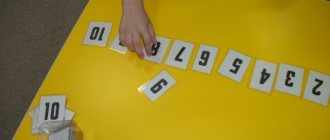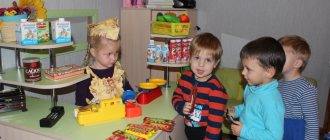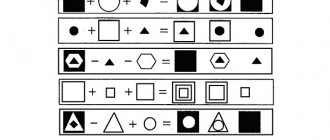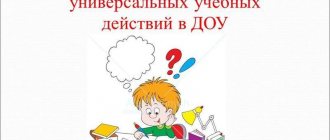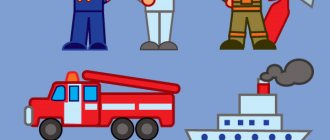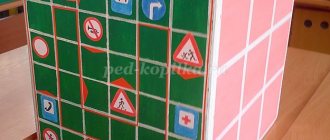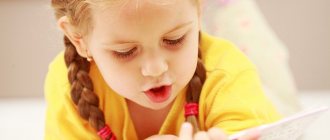Puzzles for schoolchildren with solutions and answers.
Mathematical problems vary in complexity, so start solving them with your child in kindergarten. Mathematical puzzles are almost always popular with children, so you won’t need to force your child to study. We will try to tell you about the benefits that mathematical puzzles bring to children, and what kind of puzzles can be offered to schoolchildren of a certain age to solve.
Why do we need math puzzles for children?
Mathematics is considered the most difficult science, which can cause a student a lot of problems while studying. But without ordinary mental arithmetic skills and various mathematical techniques, it is simply impossible to live normally in the future.
Long and rather complex mathematical classes, especially from 1st to 4th grades, tire children and do not give them the opportunity to properly assimilate the information they hear. If you want to prevent this from happening to your child, encourage him to study mathematics in a playful way, for example, in the form of mathematical puzzles or rebuses.
Many modern schoolchildren love to have fun with computer games or communicate on social networks with classmates in their leisure time. However, today there are those children who do not spend their own time on such toys, but give preference to the development of logic and intelligence.
Currently, the Internet is filled with a variety of sites where you can easily find logical riddles and puzzles. They are intended not only to waste your own time, but also to provide useful, and most importantly, entertaining entertainment. Many parents have already been able to appreciate the benefits of mathematical puzzles, charades, puzzles, and puzzles, since thanks to them their children were able to develop much faster.
Thanks to mathematical puzzles and problems, the child begins to reason more correctly much faster. His mind and logic are formed.
Puzzles for children
The advantage of math puzzles is that they are not considered ordinary math problems. From the first meeting, they interest children with their original presentation, arouse in children the desire to quickly find the solution to this or that puzzle.
If you and your child begin to regularly find solutions to mathematical puzzles, your child will very soon begin to solve more complex problems without problems, which he could not solve before. Get your child interested in ordinary mathematics, and mathematical puzzles will help you with this.
Mathematical puzzles and riddles are riddles of varying degrees of difficulty, composed using graphic elements. Solving such puzzles is very exciting. In addition, older children with great pleasure can independently compose mathematical puzzles for friends and classmates, which will allow them to better train their own mind and intellect, plus develop logic.
If the puzzles are presented in the form of complex riddles, children have to “rack their brains” a little in order to find the right solution. During this exciting and educational activity, your child will develop non-standard solutions. In the future, this skill will be useful for your child to find possible ways out of various situations.
And most importantly, math problems and puzzles will give your child a lot of positive mood. If he solves such puzzles with friends or with you, he will be able to further socialize and strengthen relationships.
Now let's figure out how to solve mathematical puzzles correctly. Colorful pictures depicting certain objects, numbers, signs and letters constantly arouse “mad” interest in children. But such pictures, as a rule, seem to them to be pure chaos. And all because children do not know how to solve puzzles correctly.
Puzzles vary in difficulty
Accordingly, they think that such pictures do not make sense. But this can be easily corrected if you carefully study the main rules for solving these puzzles:
- The names of the pictures that are encrypted are presented in the nominative case only. When you look at a picture of an object, think about what name this image might have. Accordingly, if you see an eye in the picture, then perhaps “eye” will be encrypted in the picture. Never settle on one answer.
- If the picture shows a comma, it means that a specific letter or several letters at the same time need to be removed from this word. Everything will depend on where the comma is located: before the image or after it.
- Often in puzzles of this kind there are letters that are underlined. This is very easy to solve. You guess the word in the picture, and then remove the letters that are underlined. If the picture shows underlined numbers, then you need to remove the letters that correspond to the serial number. If there are numbers and letters next to the image that is not underlined, then you need to leave only these letters.
- If the picture shows the value B = P, then you need to replace the letters “B” with the letter “P”. If you see this equality 2 = O, then replace the second letter in the word with “O”. There may also be an arrow in the picture, for example, from the first letter to the third, then they just need to be replaced with each other.
- There are pictures that are shown upside down. Then read the word from the end.
- There are mathematical puzzles that contain a fraction . They are easy to decipher: you need to insert the preposition “on”. If there is a “2” in the denominator, it means “gender”. In some cases, you may notice that there is a syllable or letter in the inner part of the letter. It is interpreted as follows: for example, if there is “Yes” inside the letter “O”, then this picture means “Water”.
There are other rules that will help you learn to solve complex puzzles or numerical puzzles. But the child should get acquainted with them after he learns to solve simple problems.
Puzzles with a child
Spend your free time with your children more often. Solve puzzles with them, teach them to find solutions to these puzzles, as this has a positive effect on the brain activity of the developing organism.
Verbal puzzles
Let's start with the fact that a rebus is a secret letter. It can only be written and read by someone who knows some rules. We will now begin to study them. After becoming familiar with the rules of compilation and having practiced solving our puzzles, you can try to compose your own puzzles and invite both children and adults to solve them.
First appointment. Reading the drawings
This is a fairly simple technique: you need to pronounce the names of the drawn objects correctly and in the right sequence (necessarily in the nominative case!). And see what happens.
Task 1.
What does grandma like to treat her grandson Slava to?
Solution.
What do we see in the picture? We see a word where, instead of some part of this word, a SHOWER is drawn. Let's read it like this: OLA DUSH KI. That’s right, Slavik’s grandmother loves to treat him to pancakes!
Answer:
pancakes.
Reception second. Plural letter
This is one of the simplest techniques. If you see that a certain letter is repeated many times in a rebus, you should think about it. Perhaps this means that instead of repeating this letter several times, it is worth counting the number of them. And then just say the number along with the letter. Let's try!
Task 2.
What word do you think is encrypted in the picture?
Solution:
Let's read what is written. "OOO". Some kind of nonsense. What will happen if we use our Second Technique? Let's count the number of letters O, there will be exactly THREE. Let's just say: THREE Oh, what happened? That's right, TRIO. Do you know what TRIO is? This is an ensemble with only three performers.
Answer:
trio.
Reception third. Encrypted pretext
This is one of the most common techniques. Using it, you can encrypt (and, therefore, decrypt!) many words. It consists in taking into account not only the written letters in a word, but also their position relative to each other. In this simple way you can encrypt many prepositions: ON, IN, FOR, FROM, UNDER, ABOVE, ON and even FROM (“seeing” this preposition in the picture is more difficult, but also possible). The essence of this trick is based on the fact that many words have prepositions hidden inside. For example, the word CONSTRUCTION contains the preposition PO. And hidden in the word ROPE is the preposition NA. To decipher such a rebus, you simply need to determine how the letters are located relative to each other and voice this arrangement. However, it should be remembered that such a reading often has two options, which we will see in the next example.
Task 3.
What was the name of the boy who encrypted his name with a picture?
Solution.
In the picture we see a large letter A, inside of which the syllable “SLA” is written. Let's read it this way: IN A SLA, that is, VASLA. It seems that we did everything correctly, as we were taught, but what we got was something wrong. The word VASLA does not exist. How to be? Or maybe try to say it differently: SLA V A, or SLAVA. Hurray, that's the name!
Answer:
Glory.
Task 4.
What word is encrypted in the picture?
Solution.
In the picture we see a snake that is crawling towards the letter A. All this is under the letter P. What snakes do we know? A boa constrictor, a cobra, really... All that remains is to somehow voice everything drawn so that it becomes a word. Namely: UNDER R – UZH K A.
Answer:
girlfriend.
Thus, in the above task we used the “Encrypted preposition” technique 2 times and the “Reading pictures” technique 1 time.
We will focus on these three methods for now, and then we will apply them in practice.
Well, now you are a savvy and knowledgeable detective enough to unravel all the secret messages! But do not forget that in addition to the rules, to correctly read what is written you will also need ingenuity and logic.
Mathematical puzzles with answers for 1st grade children: photo, solution, description
If your child starts solving logic problems from the 1st grade, he will quickly develop intelligence, thinking, and the ability to draw correct conclusions and perform analysis. It is this approach to increasing mathematical capabilities that has the greatest positive side for the formation of correct thinking in children.
We all know that a program compiled for school, as a rule, only involves teaching children to solve certain types of problems. Scientists argue that it is more important that a first-grader, from the very first steps of school, be able to learn to think well and reason correctly. They also confirmed that non-standard problems, which need to be solved using ingenuity and a little thinking, very often put those children who are excellent students at school in a difficult situation.
We offer you a large number of mathematical puzzles for schoolchildren. Solve them together with your children, find the right solutions together, relax so that the child finds it interesting.
First puzzle:
Numbers that are the same are indicated in the picture by the same elements. Different numbers are different.
The first puzzle (see the original source here)
Think together, what number did the magician decide to turn into a snake?
Solution:
In the first example, the snake and turtle can hide the following pairs of numbers: 0 – 4 or 1 – 3. Now add these numbers. In the first case you will get 4, in the second – also 4.
In the second example of the rebus, only the second combination of numbers is suitable, since if you subtract 2 from 3 you get 1.
Answer: a unit is hidden behind the snake.
Second puzzle:
Second puzzle
Solution:
In the word “bone”, replace “O” with “I”, and remove the last letter altogether. In the second word, replace “I” with “A”.
Combine these two words.
Answer:
Brush.
Rebus three:
Rebus the third
Solution:
The picture shows a watering can. Before this word put “K”, and remove the last two “K” and “A”.
Answer:
Glue.
Fourth puzzle:
Rebus fourth
Solution:
The picture shows a cloud. Place an “R” in front of this word and remove the first letter “T”.
Answer:
Cloud.
How can you use them?
You can solve puzzles in lessons with children of primary school age, as well as preschoolers in a kindergarten or aesthetic center, if they already know the numbers and can navigate them. At school, you can use puzzles with Roman numerals, although it will be more difficult for children to solve them.
Of course, you can’t base math classes entirely on puzzles. But the lesson can be significantly diversified if, after several difficult tasks, you offer a fun puzzle for the children. If classes are held in a children's center or kindergarten, then mathematical puzzles for children can be offered daily, between games or other activities. Of course, they should be tied to learning numbers, since children at this age are still poorly versed in numbers.
Mathematical puzzles can be given to children at home, of course, taking into account that their parents will help them at home. At school, in an open lesson, if the teacher resorts to this kind of task, he will certainly be successful.
How to solve mathematical puzzles? Let's give a few examples.
So, the first part of the word in the rebus is encrypted in the form of the word “glasses”, in which you need to remove the first and third letters. This is how we get "chi". Next, we subtract the last letter from the word “elephant”. We get the word “number”.
Another puzzle. The first part of a word is the note located in the middle of the first line on the staff (“E”). The second part of the word is “nose”, in which the second letter is equal to “y”. If you add everything together, you get a “minus”.
So, the rebus is not complicated, and younger schoolchildren can also understand the principle of its construction. When children become comfortable with puzzles, you can invite them to come up with mathematical puzzles themselves. The guys love these kinds of tasks. When everyone has come up with at least one or two problems, ask the others to guess. To do this, kids must draw pictures for their puzzles on sheets of paper or on the board.
Another option for using puzzles is to prepare a children’s work competition. This can be done during math week or in preparation for a holiday. Hang works with puzzles in a prominent place, for example, in the hall or assembly hall. It will be very interesting for parents to look at children's works and try to solve them. It is better not to post puzzles with answers, so as not to deprive the audience of intrigue.
Mathematical puzzles with answers for 2nd grade children: photo, solution, description
In 2nd grade the program is more difficult than in 1st grade. The learning process becomes more labor-intensive, so you need to help your child.
Of course, studying is necessary, but the student cannot be overloaded. The curriculum given at school and homework will be enough. There are some schoolchildren who do great at school, but when they come home, they begin to refuse to do their homework.
But you know that children definitely need to repeat the material they have covered at school, learn something new, pick up words that are new to them, develop their own thinking, and so on. Perhaps you think that your child in the 2nd grade has already become more mature, you begin to give him a lot of new information in the form of additional lessons, and then you wonder why your efforts do not produce positive results.
The fact is that your baby gets tired at school, he wants to play a little and have a good rest. A game, for example, mathematical puzzles, will help him with this. There are a large number of such puzzles. But there are parents who make the mistake of choosing an entertaining puzzle that is not age appropriate.
Don't do this either. Carefully study the options for mathematical puzzles that we offer you. They are intended specifically for 2nd grade students.
First puzzle:
Solution:
The picture shows a key. Remove the last two letters of this word. And at the end of the word itself put “YK”.
First puzzle
Answer:
Fang.
Second puzzle:
Second puzzle
Solution:
The picture shows an umbrella. Remove the last two letters from the word. Place a “U” in front of the word and a “R” at the end.
Answer:
Pattern.
Third puzzle:
Third puzzle
Solution:
The picture shows a leaf. Instead of the letter "L" put the letter "A".
Answer:
Stork.
Mathematical puzzles with answers for 3rd grade children: photo, solution, description
Puzzles that are intended for 3rd grade schoolchildren can be divided into several types. It all depends on the discipline in the school to which these puzzles belong. They can also be divided according to difficulty level.
Teachers have repeatedly proven that mathematical puzzles help students learn the learning process more effectively. They claim that thanks to such puzzles, the child begins to think well and develops creative ability. Math puzzles also help improve your mood in order to study new subjects.
It is very difficult to identify those puzzles that are suitable for a 3rd grade student. We would like to offer you some options that you can solve with your child.
First puzzle:
First puzzle
Solution:
The picture shows a rhombus. Remove the last two letters "M" and "B". Put a “K” in front of the word and a “T” at the end.
Answer:
Mole.
Second puzzle:
Second puzzle
Solution:
The picture shows a house. Remove the first letter "D". Place the letter “L” in front of the word.
Answer:
Scrap.
Third puzzle:
Solution:
Third puzzle
The picture shows an upside down house. This means that the word must be read from the end. Add the letter “A” to the end of the word.
Answer:
Fashion.
Fourth puzzle:
The fourth puzzle
Solution:
This version of the mathematical puzzle depicts letters and numbers. You need to do the following: instead of the number 100, write in letters, and then connect all the letters.
Answer:
Infusion.
Mathematical puzzles with answers for 4th grade children: photo, solution, description
Schoolchildren in the 4th grade are already beginning to become familiar with spatial concepts. Children study superficial geometric figures and their simple properties, and gradually begin to make simple drawings, using primitive measuring instruments. It is during this period of time that children begin to form the basis for future learning.
Schoolchildren move on to a more complex science, which will very soon be divided into a couple of courses: the first course is algebra, the second is geometry. Often, in order for students to have a little rest from a difficult lesson, teachers use additional tasks, for example, mathematical puzzles and rebuses. We offer you some of them that you may be able to solve with your child.
First puzzle:
First puzzle
Solution:
In the picture you see the word and an image of the object “knife”. Instead of the number 100, write the word “hundred”. Remove the first letter from the front of the word “knife”. Connect all the letters.
Answer:
Watchman
Second puzzle:
Second puzzle
Solution:
The picture shows a mushroom. Remove the first letter from the front of the word. Instead of the letter "I" put the letter "Y". Place “KA” at the end of the word.
Answer:
Fish.
Third puzzle:
Third puzzle
Solution:
The picture shows a leaf and a goose. In the first word, swap the letters as shown in the picture. In the second word, remove the first three letters. Then try to read what you got.
Answer:
Style.
Mathematical puzzles with answers for 5th grade children: photo, solution, description
For students who have already reached the 5th grade and above, there are their own complicated mathematical puzzles. Children must work seriously on them to find the correct answer. If this does not happen, the problems simply will not interest the children and then they will not be useful.
For fifth graders we offer you the following puzzles:
First puzzle:
First puzzle
Solution:
The picture shows a wasp and a shot. Since we have a fraction here, the solution is this: under the letter “H” there is a wasp. Subtract the last letter from the word “wasp”. And then fold it under + n + os (the last letter is already missing).
Answer:
Tray.
Second puzzle:
Second puzzle
Solution:
The combination “FOR” is in the letter “A”. The solution is: in + a + for.
Answer:
Vase.
Tangram
According to legend, the puzzle was created several thousand years ago by three ancient Chinese sages for the son of an emperor. The ruler wanted his son to understand the beginnings of mathematics through a simple game, learn to see the world around him through the eyes of an artist, become patient like a philosopher, and realize that complex things are made up of simple ones.
This is how “Shi-Chao-Tyu” appeared - a square cut into seven parts
: 5 triangles (2 large, 2 small, 1 medium), a square and a parallelogram.
The essence of the “free” game of tangram is to assemble all kinds of figures from existing parts using the principle of a mosaic: animals, birds, humans, whatever. Younger preschoolers are offered a simple version of an educational game, when tangram figures just need to be placed on a ready-made sample answer.
Many children aged 5-7 years put together models of figures next to the answer image, even if the sizes of the cut out figures and parts in the picture are different.
Tangram as a puzzle
Usually a child can do it from 6-7 years old. Everything is the same - you need to put together a finished model from tangram elements, but the card shows only the silhouette of the figure.
Cut out the elements of a tangram from a paper, cardboard or other square, and to begin with, we suggest assembling one of the popular figures - a running man, as in the picture above.
Remember 2 rules of the puzzle:
1) you must use all 7 puzzle pieces; 2) the figures should not overlap each other.
Show finished figurine
Tangram fans included Lewis Carroll and Napoleon Bonaparte. It is believed that it was the American chess player, inventor of “tags” and many other puzzles, Samuel Loyd who called the game “tangram”. In the 21st century, the most interesting manifestations of tangram are found in furniture design, clothing, landscape design and architecture.
Tangram: answer
You can pre-color the elements of the tangram and you will get this little man:
Mathematical puzzles with answers for 6th grade children: photo, solution, description
In 6th grade, children are already becoming adults. This means that math puzzles also need to be more difficult.
First puzzle:
First puzzle
Solution:
The picture shows an upside down mushroom and a wasp. Proceed as follows: read the word “mushroom” backwards. In the same word, replace the letter “G” with the letter “K”. Subtract the first two letters from the word “wasp”. Fold the remaining letters.
Answer:
Tag.
Second puzzle:
Second puzzle
Solution:
Here, to find a solution, the child will have to think a little. Don't tell him the answer right away. Let your student think about the answer himself, and you listen to what kind of solution he will offer you.
Answer:
Tram.
Mathematical puzzles with answers for 7th grade children: photo, solution, description
As a rule, in the 7th grade, children begin algebra and geometry. They are already familiar with many geometric figures, their thinking is better developed than that of primary school students. This means that these children need math puzzles with a high degree of difficulty.
First puzzle:
First puzzle
The picture shows a combination of letters and numbers. Instead of the number 100, write the word “hundred”. Now connect all the letters. You'll actually have to think a little.
Second puzzle:
Second puzzle
The picture shows the number 7, the letter “K” and a mouth. Write “7” with the word “seven” and subtract the last two letters from it. The mouth is shown upside down. This means you need to read it backwards from the end.
Rebus three:
Third puzzle
The picture shows a pen with a meter. The comma indicates that you need to remove the last letter from the word “feather”. Everything is very simple. Connect the letters that remain from the word “feather” with the letter “I” and the word “meter”.
Puzzles, crosswords, riddles, anagrams
Explanatory note
A necessary condition for studying the subject “Informatics and ICT” at the level of general education is the development of students’ cognitive activity. One of the methods of emotional stimulation of learning is the method of stimulation with entertainment - the introduction of entertaining examples, games, experiments, and interesting facts into the educational process. The problem of creating and increasing motivation to study computer science at school in the process of work needs to be given quite a lot of attention. For elementary school students, this is a new subject and I want to interest them. In the middle level there are new requirements, teachers. Many students fail to cope with all this and significantly reduce their academic performance. In the lower grades, children should play more during their studies and enjoy learning. They are not ready to accept “dry” theory even at the middle and even senior levels, so it is necessary to continue to “revive” the learning process.
Puzzles are a very entertaining and popular type of task that can spice up a lesson. They first appeared in the 15th century in France, and in 1582 the first printed collection of rebuses, compiled by E Taboureau, was published. Puzzles are of great interest to children, regardless of age. They bring their own flavor to the learning process. In such classes, important qualities of the child’s personality are formed: independence, observation, resourcefulness, intelligence, perseverance is developed, and constructive skills are developed. They teach children to think logically.
A puzzle is a complex, sometimes intractable riddle or task. I will give examples of language puzzles: riddles, anagrams, cryptograms, rebuses, crosswords, which I use in my lessons.
Using puzzles is an effective way to increase students' interest in a subject. And this is one of the components of the triune goal of the lesson - educational.
For example, a riddle is a tricky, intricate question in which what is riddled is always hidden under a “mask”; only a hint is made to the subject of the riddle. A riddle is a means of education, training, development of children, an exercise in reasoning, in the ability to prove. The subject of the riddle should be informative; you can talk about its creation, its actions, what they do with it, etc. Examples of riddles for elementary school - Appendix 1.
Anagram (rearrangement of letters), a word or phrase formed by rearranging the letters of another word or phrase. (Appendix 2).
In a cryptogram, a sentence or statement is encrypted using the simplest technology: each letter of the alphabet is replaced by some other letter or encoded by a number. So, in computer science lessons in primary and secondary schools, studying the topic “Information Coding,” I use cryptograms. For example, I show on the screen a table with a coded word, and on the children’s tables there are cards with the alphabet, where not only the letters, but also the numbers of these letters in the alphabet. I turn to the children: “What do you think we will do now? To find out, let's decode the word that is on the board." But first we need to clarify the rules. For example, this word is encoded by replacing each letter with the previous or subsequent letter of the alphabet (or one or two letters later). Example: The word "Computer Science" can be "Johpsnbuilb" if each letter is replaced by the next letter of the alphabet.
Or the next moment of the lesson is encoded in numbers - reinforcing material on a specific topic using puzzles. In order to find out what task will be next, I suggest deciphering the encoded word. I give the students cards with tables in which the word is encoded. We need to figure out what the next stage of the lesson is. Children solve the word, for example, puzzles. They love to solve puzzles.
| 18 | 6 | 2 | 21 | 19 | 29 |
| R | E | B | U | WITH | Y |
Or this task: Restore the sentence
| 1 | 2 | 3 | 4 | 5 | |
| 1 | scanner | before | thinks | , | prints |
| 2 | Not | Computer | feeds | paper | A |
| 3 | Human | But | cipher | decides | Printer |
Words from sentences are inserted into the table. You need to compose the sentence encoded in the table by looking at the coordinates that are written in parentheses below the table. Remember that first we look at the number horizontally, and then vertically.
(2;2) (4;3) (4;1) (2;3) (3;1) (1;3)
Answer: The computer decides, but the person thinks
The next type of puzzle that children really like is crosswords. If a crossword puzzle is supposed to form new knowledge in students through questions, then this is a crossword puzzle of an educational nature. Such crosswords can be offered at the stage of initial comprehension. If crossword questions are designed to attract students to learn new material or are aimed at increasing interest in the subject, then this is a motivational type of crossword. And if through them, based on the studied material, it is supposed to prepare students for the perception of new material, then this is an updating crossword puzzle.
To control knowledge of one topic, I compose crosswords with questions on the current topic, and to generalize and systematize - on several topics. (Appendix 3).
Crosswords allow you to simultaneously update and acquire new knowledge. Crosswords are useful for everyone, as they broaden their horizons and help them better navigate the ever-increasing flow of information. Solving crossword puzzles trains memory, sharpens intelligence, teaches how to work with a textbook, stimulates interest in deepening knowledge, and develops the ability to finish a job.
Rebuses
A rebus is a riddle in which the searched word or phrase is encoded in the form of pictures, signs, letters, i.e. "objects". One of the main difficulties when solving puzzles is the ability to correctly name the object depicted in the picture and understand how the fragments of the picture relate to each other. They help develop logic, attention, intelligence, and ingenuity. They can be used both at the beginning of a lesson to determine the topic, and when reinforcing the material. (Appendix 4).
The use of puzzles in computer science lessons makes it possible to increase students' motivation and give them knowledge.
By solving puzzles, children learn to plan their actions, think about them, and be creative. This work activates the mental activity of students.
Puzzles based on educational material allow you to diversify the forms of work with students. They can be used to test the assimilation of terms and their definitions at the end of studying a topic, section or entire discipline before the final test.
Sometimes, in my practice, I offer children creative homework assignments on a topic. This is composing crosswords, puzzles, riddles, or coming up with your own example of encoding information using some of your own notations. I use tasks like this for peer review. Children share their examples with pleasure. At the same time, it is immediately noticeable how much better the children studied the topic in the textbook. By solving puzzles, children learn to work with a book and choose the most appropriate (short and precise) formulations for terms or give them themselves, while simultaneously repeating and consolidating educational material; they master the correct spelling of terms and definitions for them, so such work is important. They find errors in the definition, spelling of terms, inaccuracies in the question asked or an incorrectly composed rebus.
Puzzles harmoniously develop a whole range of intellectual abilities: logical-theoretical, spatial thinking and imagination, heuristic and creative thinking, practical skills in research behavior.
Appendix 1_riddles DOCX / 21.58 KB Appendix 2_anagrams DOCX / 22.64 KB Appendix 3_crosswords DOCX / 118.56 KB Appendix 4_rebuses DOCX / 171.37 KB
